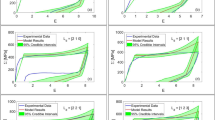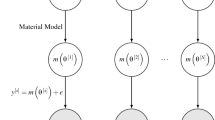Abstract
This paper presents a new method for quantifying uncertainty in the predictions of a nanomaterial computational model to account for variability in the constituent nanostructure properties and characterization measurements. The stiffness of a buckypaper–polymer composite is predicted using a micromechanics model. The model requires from the user as inputs the nanostructure properties, including the diameter, length, and curvature distribution of the carbon nanotubes which shows large variability. The current characterization techniques used to describe these dimensions are subject to considerable measurement error. We propose a constrained nonlinear programming approach for quantification of raw material variability and its impact on the property prediction of buckypaper–polymer composites. The uncertainty quantification method is useful for decision making to predict probability that the quality characteristic of the final part will satisfy design constraints. A case study based on data from a real buckypaper manufacturing process was used to illustrate the approach. It is shown that modeling the correlation between nanostructure properties using a multivariate distribution rather than independent univariate distributions is important to accurately quantify the effect of these properties on the final-part property.
Similar content being viewed by others
References
Berhan L, Yi YB, Sastry AM (2004) “Effect of nanorope waviness on the effective moduli of nanotube sheets”. J Appl Phys 95(9):5027–5034
Baughman RH, Zakhidov AA, de Heer WA (2002) Carbon nanotubes—the route toward applications. Science 297(5582):787–792
Chantrasmiy, T., Constantine, P., Etemadiz, N., Iaccarino, G. and Wang, Q. (2006). "Uncertainty quantication in simple linear and non-linear problems." Center for Turbulence Research Annual Research Briefs
Chen W, Xiong Y, Tsui KL, Wang S (2008) A design-driven validation approach using Bayesian prediction models. ASME J Mech Des 130:021101
Eshelby JD (1957) The determination of the elastic field of an ellipsoidal inclusion and related problems. Proc Roy Soc Lond Math Phys Sci 241(1226):376–396
Frenkel D, Smit B (2002) Understanding molecular simulation: from algorithms to applications, 2nd edn. Academic Press, San Diego
Hanson KM, Hemez FM (2001) A framework for assessing confidence in computational predictions. Exp Tech 25:50–55
Hsiao HM, Daniel IM (1996) Elastic properties of composites with fiber waviness. Compos Appl Sci Manuf 27(10):931–941
Iaccarino, G., Eldred, M., Doostan A. and Ghattas O. (2009). “Introduction to uncertainty quantification.” SIAM Conference on Computational Science and Engineering Report
Kennedy MC, O’Hagan A (2001) Bayesian calibration of computer models. J Roy Stat Soc B Stat Meth 63:425–450
Knight K (1999) Mathematical statistics. Chapman & Hall/CRC, London
Montgomery DC (2012) Design and analysis of experiments, 8th edn. Wiley, Hoboken, NJ
Mori T, Tanaka K (1973) Average stress in matrix and average elastic energy of materials with misfitting inclusions. Acta Metall 21(5):571–574
Nikitin Y (1995) Asymptotic efficiency of nonparametric tests. Cambridge University Press, Cambridge, UK
Press WH, Flannery BP, Teukolsky SA, Vetterling WT (1992) Numerical recipes in FORTRAN 77: the art of scientific computing. Cambridge University Press, Cambridge, UK
Qian PZG, Wu CFJ (2008) Bayesian hierarchical modeling for integrating low-accuracy and high-accuracy experiments. Technometrics 50(2):192–204
Salvetat JP, Briggs GAD, Bonard JM, Bacsa RR, Kulik AJ, Stockli T, Burnham NA, Forro L (1999) Elastic and shear moduli of single-walled carbon nanotube ropes. Physical Review Letters 82(5):944–947
Santner TJ, Williams BJ, Notz WI (2003) The design and analysis of computer experiments. Springer, New York, NY
Sheskin DJ (2000) Handbook of parametric and nonparametric statistical procedures, 2nd edn. Chapman & Hall, Boca Raton, FL
Shi DL, Feng XQ, Huang YY, Hwang KC, Gao H (2004) The effect of nanotube waviness and agglomeration on the elastic property of carbon nanotube-reinforced composites. Trans ASME J Eng Mater Tech 126:250–257
Smart Image Technology (2010) http://smartimtech.com. Accessed 30 June 2010
Starr FW, Schroder TB, Glotzer SC (2002) Molecular dynamics simulation of a polymer melt with a nanoscopic particle. Macromolecules 35:4481–4492
Thess A, Lee R, Nikolaev P, Dai H, Petit P, Robert J, Xu C, Lee YH, Kim SG, Rinzler AG, Colbert DT, Scuseria GE, Tombnek D, Fischer JE, Smalley RE (1996) Crystalline ropes of metallic carbon nanotubes. Science 273:483–487
Tsai, C.-H. (2010). Elastic properties prediction and variation quantification for buckypaper-polymer nanocomposites: modeling and experimental validation. Ph.D. dissertation, Department of Industrial and Manufacturing Engineering, Florida State University
Tucker CL III, Liang E (1999) Stiffness predictions for unidirectional short-fiber composites: review and evaluation. Compos Sci Technol 59:655–671
Wang S (2008) Role of structure and morphology in the elastic modulus of carbon nanotube composites. J Mater Sci 43:5837–5844
Wang SR, Liang ZY, Wang B, Zhang C (2006) Statistical characterization of single-wall carbon nanotube length distribution. Nanotechnology 17(3):634–639
Wang Z, Liang ZY, Wang B, Zhang C, Kramer L (2004) Processing and property investigation of single-walled carbon nanotube (SWNT) buckypaper/epoxy resin matrix nanocomposites. Compos Appl Sci Manuf 35(10):1225–1232
Yeh, C. S. (2007). A study of nanostructure and properties of mixed nanotube buckypaper materials fabrication, process modeling characterization, and property modeling. Industrial and Manufacturing Engineering. Ph.D. dissertation, Department of Industrial and Manufacturing Engineering, Florida State University
Zeng QH, Yu AB, Lu GQ (2008) Multiscale modeling and simulation of polymer nanocomposites. Prog Polym Sci 33(2):191–269
Author information
Authors and Affiliations
Corresponding author
Appendix
Appendix
Rights and permissions
About this article
Cite this article
Vanli, O.A., Chen, LJ., Tsai, Ch. et al. An uncertainty quantification method for nanomaterial prediction models. Int J Adv Manuf Technol 70, 33–44 (2014). https://doi.org/10.1007/s00170-013-5250-0
Received:
Accepted:
Published:
Issue Date:
DOI: https://doi.org/10.1007/s00170-013-5250-0




